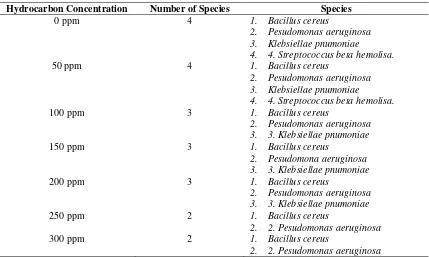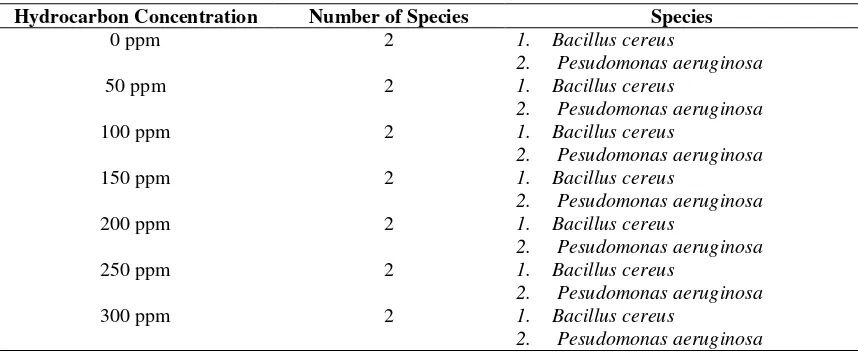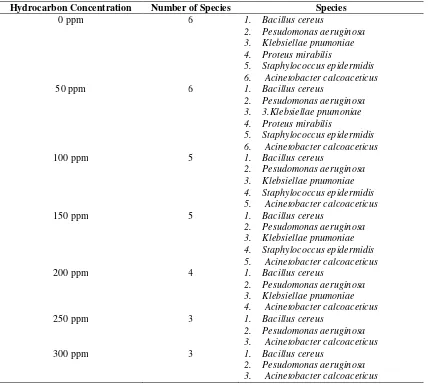ISSN: 2339-076X, Volume 1, Number 4 (July 2014): 201-206 DOI:10.15243/jdmlm.2014.014.201
www.jdmlm.ub.ac.id 201
Research Article
Exploration of hydrocarbon degrading bacteria on soils contaminated
by crude oil from South Sumatera
A. Napoleon
*, D.S. Probowati
Department of Soil Science, Faculty of Agriculture, Sriwijaya University Jl. Palembang – Prabumulih Km. 32 Indralaya, South Sumatera, Indonesia Telp. 62 – 711- 580460, Fax. 62 – 711 – 580276l
* Corresponding author: [email protected]
Abstract:
The goal of this research was to explore hydrocarbon degrading bacteria on crude oil contaminated soil with potential to degrade hydrocarbon in oil pollutant. The research started by early August 2013 till January 2014. Soil sampling for this research was taken on several places with contaminated soil location such as Benakat, Rimau, and Pengabuan all of it located in South Sumatera. Conclusion from this research Isolates obtained from three (3) sites of contaminated soil and treated using SBS medium wereBacillus cereus,Pseudomonas aeruginosa, Klebsiella pnumoniae, Streptococcus beta hemolisa, Proteus mirabilis, Staphylococcus epidermis and Acinotobacter calcoaceticus. Isolates that survived on 300 ppm of hydrocarbon concentration wereBacillus cereus, Pseudomonas aeruginosaandAcinetobacter cakciaceticus Selected isolates posses the ability to degrade hydrocarbon by breaking hydrocarbon substance as the energy source to support isolates existence up to 1,67 TPH level. Based on results accomplish by this research, we urge for further research involving the capacity of isolates to degrade wide variety of hydrocarbon substance and more to develop the potential of these bacteria for bioremediation.
Keywords :bioremediation, contaminated soil, hydrocarbon
I
ntroduction
Oil and gas industry has been known as a major contributor for land pollution. Contamination due to oil spill is a major issue that needs immediate attention. One of the main results of oil pollution is oil sludge. Oil sludge contaminant is an issue that every oil & gas company must face these recent days. Difficulties when dealing with oil sludge is caused mainly to its quantity, not to mention that oil sludge is classified as B3 pollutant (LPPM, 2004).
Sludge oil contains hydrocarbon substance and non hydrocarbon which posses’ physical and chemical character that has the potential to decrease the quality of environment, poisoning biological life, disturbing food chain, and because of that sludge is categorized as B3 pollutant according to PP No.18 1999. As B3 pollutant, treatment of oil sludge must be able to reduce and decrease its toxic nature before disposal (Munawar, 1999). Microbiological control is an
alternative to handle pollution due to oil spill. Crude oil contains a large variety of hydrocarbon substance which determines its reaction to biodegradation by microbe. Effort to increase the speed of biodegradation of oil’s hydrocarbon can be obtained trough creating optimal condition and metabolism for natural microbe (Pikoli et al., 2000).
purpose of cleaning oil spill by oxidation of oil to become CO2 and reduce the dangerous nature of it. Hydrocarbon degrading bacteria can be utilized as bioremediation agent to promote the condition of environment. Collection of these bacteria is necessary to optimize its usefulness to support the availability of farming land. According to Gadd (1998), bacteria possessing the ability to degrade hydrocarbon is widely spread especially in an environment highly exposed to pollution. According to Ilyina (2003) search for hydrocarbon degrading bacteria in Mexico has found that there are several genus ofBacillus sp,
Rhodococcus sp, Providencia sp andCitrobacter Sp that has good prospect for bioremediation application. According to Ni’matuzahroh (2004), result of isolation and identification for hydrocarbonoklastic from the polluted beaches of Surabaya showed that several bacteria strain including several genus of Pseudomonas, Alcaigenes, Acinetobacter, Arthrobacter, Moraxella, Pediococcus. Flavobacterium, Micrococcus had a lot potential to be developed in bioremediation effort.
Based on that, the benefit of hydrocarbon degrading bacteria has triggered further research. This research will isolate indigent bacteria that shows potential in degrading hydrocarbon, and it is necessary since these sort of research is seldom conducted here in South Sumatera. The goal of this research was to explore hydrocarbon degrading bacteria on oil contaminated soil with potential to degrade hydrocarbon in oil pollutant.
Materials and Methods
Soil sampling for this research was taken on several places with contaminated soil location such as Benakat, Rimau and Pengabuan all of it located in South Sumatera. Enrichment of microorganism was held at Biology Laboratories of Soil study. This research was conducted on August 2013 till January 2014. Material used in this research were 1) sludge oil 2) aquadest 3) Alcohol 70% 4) medium SBS, Nutrient Broth, Nutrient Agar, and Hydrocarbon for analisis, Aluminium foil, autoclave, Bunsen, colony counter, petridish, becker glass, erlermeyer, ose, testcup, and incubator.
This research was started by isolating hydrocarbon degrading bacteria on oil sludge pollutant from various places. Bacteria culture was created by growing bacteria on selected solid minimum media contained hydrocarbon by adding hydrocarbon substance gradually as the only source of carbon and energy. Data observed including: bacteria type up until genus level and
indicated by decreasing percentage of TPH. There were 3 steps in this research
1. Preparation: In this step, activity including pleminary consultation, reading material that related to this research and preparation of tools and materials
2. Field work: Sample in this research were oil sludge which taken directly from waste processing installation. The sample was kept in cooler box for transport.
3. Laboratories work: Bacteria isolation from soil contaminated thrugh purification, selection, bacteria identification, and reliebility test
Results and Discussion
Isolation and Identification
There were 4 bacteria isolate obtained from oil pollutant inside SBS medium, 4 from Benakat site, 2 from Rimau site and 6 from Pengabuan site. Complete identification shown in table 1. From Table 1 we can see that isolate from genus Bacillus, Pseudomonas, Klebsiella, Streptococcus, Proteus, Staphylococcus, and Acinetobacter.
Table 1. Bacteria Identification from Benakat, Rimau and Pengabuan site.
Stie Bacteria Type
Benakat
1. Bacillus cereus
2. Pseudomonas aeruginosa 3. Klebsiella pnumoniae 4. Streptococcus beta hemolisa
Rimau 1. Bacillus cereus
2. Pseudomonas aeruginosa
Increasing the Ability to Degrade Hydrocarbon
Bacteria isolation method was directly able to select type of hydrocarbon degrading bacteria. Therefore all obtained isolate in this research were considered to have potential in degrading hydrocarbon. Hydrocarbon treatment in this research was meant to find dominant bacteria since its part to degrade hydrocarbon substance in natural still important despite its limited amount (Sharpley, 1996).
Every increment of hydrocarbon concentration on growing medium always followed by decreasing variety of bacteria survives. It was an indication that fewer bacteria would survive on high concentration hydrocarbon.
Benakat site
On this location we found 4 types of indigene bacteria isolated from oil contaminated soil taken from this site. There are Bacillus cereus,
Pseudomonas aeruginosa, Klebsiellae pnumoniae
and Streptococcus beta hemolisa. On initial hydrocarbon concentration there were 4 species of bacteria survive. This number was decreasing along with the increasing concentration of hydrocarbon. On 100 ppm, one bacterium was unable to survive. It was expected that this bacterium was more sensitive to hydrocarbon pollution than 3 other bacteria and until 200 ppm these 3 bacteria still survived by breaking
hydrocarbon chain to get carbon as energy source. On 300 ppm only 2 bacteria left with the ability to degrade hydrocarbon. So from numbers of isolates tested on hydrocarbon polluted liquid SBS medium only 2 isolates were able grow. Relationship between increasing concentration of hydrocarbon with variety of bacteria is shown in Table 2.
Based on this identification the 2 bacteria were Bacillus cereus and Pseudomonas aeruginosa. According to Yani (2005),
Pseudomonas aeruginosa is able to live on 3 substrat hydrocarbon (hexadecane, diesel and lubricant). Biodegradation percentage indicated that Pseudomonas aeruginosa was able to degrade hydrocarbon up to 35.15 % on diesel, 19.16 on hexadecane with incubation period of 21 days. It was a strong indication that Pseudomonas aeruginosa had the potential to be utilized on bioremediation.
Tabel 2. Relation between hydrocarbon concentration with number of species on Benakat site
Hydrocarbon Concentration Number of Species Species
0 ppm 4 1. Bacillus cereus
2. Pesudomonas aeruginosa 3. Klebsiellae pnumoniae
4. 4. Streptococcus beta hemolisa.
50 ppm 4 1. Bacillus cereus
2. Pesudomonas aeruginosa 3. Klebsiellae pnumoniae
4. 4. Streptococcus beta hemolisa.
100 ppm 3 1. Bacillus cereus
2. Pesudomonas aeruginosa 3. 3. Klebsiellae pnumoniae
150 ppm 3 1. Bacillus cereus
2. Pesudomona aeruginosa 3. 3. Klebsiellae pnumoniae
200 ppm 3 1. Bacillus cereus
2. Pesudomonas aeruginosa 3. 3. Klebsiellae pnumoniae
250 ppm 2 1. Bacillus cereus
2. 2. Pesudomonas aeruginosa
300 ppm 2 1. Bacillus cereus
2. 2. Pesudomonas aeruginosa
Rimau site
On this location we found 2 types of indigene bacteria isolated from oil contaminated soil taken from this site. There are Bacillus cereus and
Pseudomonas aeruginosa. On initial hydrocarbon concentration up until 300 ppm there were 2 species of bacteria survive. This number stayed even with the increasing concentration of
Tabel 3. Relation between hydrocarbon concentration with number of species on Rimau site.
Hydrocarbon Concentration Number of Species Species
0 ppm 2 1. Bacillus cereus
2. Pesudomonas aeruginosa
50 ppm 2 1. Bacillus cereus
2. Pesudomonas aeruginosa
100 ppm 2 1. Bacillus cereus
2. Pesudomonas aeruginosa
150 ppm 2 1. Bacillus cereus
2. Pesudomonas aeruginosa
200 ppm 2 1. Bacillus cereus
2. Pesudomonas aeruginosa
250 ppm 2 1. Bacillus cereus
2. Pesudomonas aeruginosa
300 ppm 2 1. Bacillus cereus
2. Pesudomonas aeruginosa
Based on this identification the 2 bacteria were
Bacillus cereus and Pseudomonas aeruginosa. Pseudomonas aeruginosa is able to live on 3 substrat hydrocarbon (hexadecane, diesel and lubricant). According to Sigiura et al. (1997),
Baccillus cereus is one of the two groups of bacteria that can speed up bioremediation process therefore it has the ability to increase the efficiency of bioremediation. The presence of these groups of hydrocarbon degrading bacteria will increase efficiency in oil bioprocess which on its turn would be potential in degrading variety of hydrocarbon component (aliphatic, aromatic and poly-aromatic) including its potential to produce biosurfaktan
Pengabuan site
On this location we found 6 types of indigene bacteria isolated from oil contaminated soil taken from this site. They were Bacillus cereus and
Pseudomonas aeruginosa, Klebsiellae pnumonia,
Proteus mirabillis, Stapphylococcus epidermidis
and Acinetobacter Cacoaceticus. On initial hydrocarbon concentration (50ppm) 6 bacteria survived and this number declining along with the increasing concentration of hydrocarbon.
On 100 ppn 1 bacterium could not survive the hydrocarbon concentration. It was assumed that this bacterium was more sensitive to hydrocarbon pollution that the rest of bacteria isolated and up until 200 ppm there were only 4 bacteria left due to its ability to break hydrocarbon chain to get carbon as its source of energy. On 300 ppm there were only 3 bacteria left. These bacteria were able to degrade hydrocarbon. So from numbers of isolate that was tested on liquid SBS medium with hydrocarbon substance, only 3 isolates were able to grow and degrade hydrocarbon. Relationship
between increasing concentration of hydrocarbon with variety of bacteria is shown in Table 4. Based on this identification the 3 bacteria were Bacillus cereus,Pseudomonas aeruginosa and Acinetobacter calcoaceticus. These 3 bacteria from Pengabuan site showed its ability to degrade sludge, crude oil and its product.
According to Ni’matuzahroh (2005), isolation and identification hydrocarbonoklastic from various research site indicated that 24 strains of bacteria from 8 genus. They are Psedomonas (9), Alcaligenes (3), Acinetobacter (3), Arthrobacter (2), moraxella (2), Pediococcus (1), Flavobacterium (2), Micrococcus (2). These bacteria have a lot potential to degrade a large variety hydrocarbon substance. The presence of these groups of hydrocarbon degrading bacteria will increase efficiency in oil bioprocess which on its turn would be potential in degrading variety of hydrocarbon component (aliphatic, aromatic and poly-aromatic) including its potential to produce biosurfaktan.
Reliability test to the selected isolated
Reliability test to the selected isolated was aimed to find out the selected isolate performance to degrade hydrocarbon substance by adding the variety and concentration of hydrocarbon substance. The parameter measured in this was Total Petroleum Hydrocarbon by using Gravimetric method (Widyastini, 2006).
Tabel 4. Relation between hydrocarbon with number of species on Pengabuan site.
Hydrocarbon Concentration Number of Species Species
0 ppm 6 1. Bacillus cereus
2. Pesudomonas aeruginosa 3. Klebsiellae pnumoniae 4. Proteus mirabilis
5. Staphylococcus epidermidis 6. Acinetobacter calcoaceticus
50 ppm 6 1. Bacillus cereus
2. Pesudomonas aeruginosa 3. 3.Klebsiellae pnumoniae 4. Proteus mirabilis
5. Staphylococcus epidermidis 6. Acinetobacter calcoaceticus
100 ppm 5 1. Bacillus cereus
2. Pesudomonas aeruginosa 3. Klebsiellae pnumoniae 4. Staphylococcus epidermidis 5. Acinetobacter calcoaceticus
150 ppm 5 1. Bacillus cereus
2. Pesudomonas aeruginosa 3. Klebsiellae pnumoniae 4. Staphylococcus epidermidis 5. Acinetobacter calcoaceticus
200 ppm 4 1. Bacillus cereus
2. Pesudomonas aeruginosa 3. Klebsiellae pnumoniae 4. Acinetobacter calcoaceticus
250 ppm 3 1. Bacillus cereus
2. Pesudomonas aeruginosa 3. Acinetobacter calcoaceticus
300 ppm 3 1. Bacillus cereus
2. Pesudomonas aeruginosa 3. Acinetobacter calcoaceticus
Figure 1 shows that the concentration of TPH from all location is 1.67 %. On the illustration we can see decreasing of TPH because of the activity of hydrocarbon degrading bacteria by breaking hydrocarbon substance into carbon as the source of energy. The decreasing of TPH was also caused by the phase of bacteria growth at its peak in which required a large amount of energy that in turn also resulted in decreasing level of TPH below the standard set by the Government.
Conclusion
1. Isolates obtained from three (3) sites of contaminated soil and treated using SBS medium were Bacillus cereus, Pseudomonas aeruginosa, Klebsiella pnumoniae,
Streptococcus beta hemolisa, Proteus mirabilis, Staphylococcus epidermis and
Acinotobacter calcoaceticus.
2. Isolates that survived on 300 ppm of hydrocarbon concentration were Bacillus cereus, Pseudomonas aeruginosa and
Acinetobacter cakciaceticus.
3. Selected isolates posses the ability to degrade hydrocarbon by breaking hydrocarbon substance as the energy source to support isolates existence up to 1,67 TPH level Based on results accomplish by this research, we urge for further research involving the capacity of isolates to degrade wide variety of hydrocarbon substance and more to develop the potential of these bacteria for bioremediation.
References
Gadd, G.M. 1998. Metal tolerance. In: Edwards, C (Ed.). Microbiology Extreme Environments. Mc. Graw-Hill Publishing Company. p. 181-209. Ilyina A. 2003. Isolation of soil bacteria for
bioremediation of hydrocarbon contamination. Universidad Autonoma de Coahuila Departamento de Biotecnologia, Saltillo. Meksiko.
Lembaga Penelitian dan Pemberdayaan Masyarakat (LPPM). 2004. Eksperimen laboratorium pengolahan lumpur minyak PT Medco E&P Indonesia menggunakan reaktor batch. Pusat Penelitian Antar Universitas Bioteknologi Institut Teknologi Bandung. Bandung.
Munawar. 1999. Isolasi dan skrining bakteri pengguna hidrokarbon di daerah rhizosfir hutan bakau yang tercemar limbah industri pengilangan minyak bumi.
Jurnal Ilmiah MIPA2 (2): 41-47.
Ni’matuzahroh, 2004. Mekanisme asimilasi hidrokarbon oleh bakteri hidrokarbon klasik Pseudomonas. Faculty of Mathematics and Natural Science Airlangga University. Semarang.
Ni’matuzahroh., 2005. Pencarian strain bakteri hidrokarbonoklastik di kawasan perairan pantai
Surabaya. Faculty of Mathematics and Natural Science Airlangga University. Semarang.
Pikoli, M.R., Aditiawati, P. and Astuti, D.I. 2000. Isolasi bertahap dan identifikasi isolat bakteri termofilik pendegradasi minyak bumi dari Sumur Bangko. Jurusan Biologi. ITB. Bandung.
Sharpley, J.M. 1996. Elementary Petroleum Microbiology, Gulf Publishing Company, Texas, 65-95, 115-117.
Sigiura, K., Ishihara, M., Shimauchi, T. and Harayama, S. 1997. Physicochemical properties and biodegradability of crude oil. Environmental Science and Technology31: 45-51.
Toccalino, P.L., Johnson, R.L. and Boone, D.R. 1993. Nitrogen limitation and nitrogen fixation during alkane biodegradation in a sandy soil. Applied Environmental Microbiology59:2977-2983. Widyastini. E. 2006. Saatnya mikroba untuk limbah



